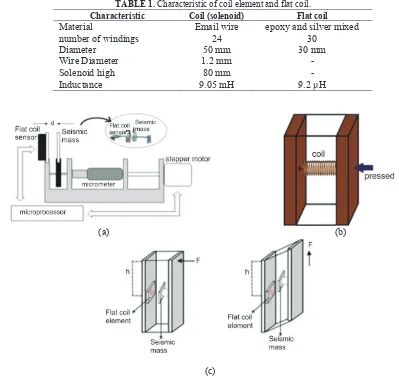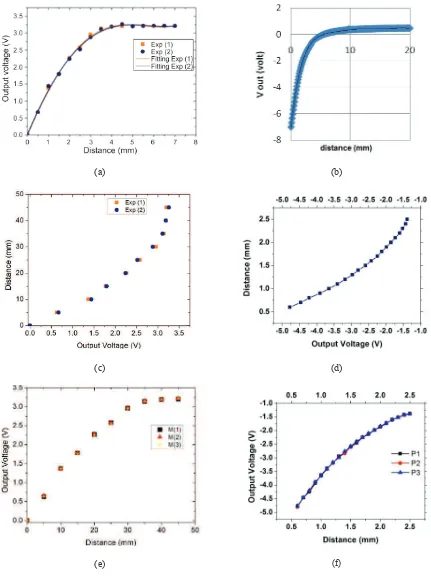A comparative study of flat coil and coil sensor for landslide detection
Edi Sanjaya, Ahmad Novi Muslimin, Mitra Djamal, Suprijadi, Gunawan Handayani, and RamliCitation: AIP Conference Proceedings 1719, 030044 (2016);
View online: https://doi.org/10.1063/1.4943739
View Table of Contents: http://aip.scitation.org/toc/apc/1719/1
Published by the American Institute of Physics
Articles you may be interested in
Development of alternating current transmitter of detection system for magnetic material in soil subsurface AIP Conference Proceedings 1719, 030047 (2016); 10.1063/1.4943742
Electric field poling 2G V/m to improve piezoelectricity of PVDF thin film AIP Conference Proceedings 1719, 030021 (2016); 10.1063/1.4943716
The study of electronic structure and properties of silicene for gas sensor application AIP Conference Proceedings 1719, 030039 (2016); 10.1063/1.4943734
Study on efficiency of time computation in x-ray imaging simulation base on Monte Carlo algorithm using graphics processing unit
AIP Conference Proceedings 1719, 030007 (2016); 10.1063/1.4943702
A simple method to determine leakage location in water distribution based on pressure profiles AIP Conference Proceedings 1719, 030045 (2016); 10.1063/1.4943740
A Comparative Study of Flat Coil and Coil Sensor for
Landslide Detection
Edi Sanjaya
1, a)Ahmad Novi Muslimin
1), Mitra Djamal
2, b), Suprijadi
2, c), Gunawan
Handayani
3, d)and Ramli
4, e)1
Department of Physics, Faculty of Science and Technology, Syarif Hidayatullah State Islamic University (UIN), Jakarta, Indonesia
2
Theoretical High Energy Physics and Instrumentation Research Group, Faculty of Mathematics and Natural Sciences, Bandung Institute of Technology, Bandung, Indonesia
3
Physics of Complex System Research Group, Faculty of Mathematics and Natural Sciences, Bandung Institute of Technology, Bandung, Indonesia
4
Department of Physics, Faculty of Mathematics and Natural Sciences, Universitas Negeri Padang, Padang, Indonesia
Abstract. The landslide is one of the most costly catastrophic events in terms of human lives and infrastructure damage, thus an early warning monitoring for landslides becomes more and more important. Currently existing monitoring systems for early warning are available in terms of monolithic systems. This is a very cost-intensive way, considering installation as well as operational and personal expenses. We have been developing a landslide detection system based on flat coil and coil sensor. The flat coil element being developed is an inductive proximity sensor for detection mass of soil movement. The simple method of flat coil manufactures and low cost, is an attraction that is still inspired to develop flat coil sensors. Meanwhile, although it has a drawback in terms of their size, the coil sensor is still required in many fields due to their sensitivity and robustness. The simple method of coil manufacture and the materials are commonly available and low cost, is an attraction that is still inspired to develop induction coil sensors. A comparative study of alternative configuration of sensor based on flat coil elements and a coil in application to landslide detection has been discussed in this paper. The purpose of this comparison is to show the ideal conditions and the challenges for each sensor. Furthermore, a comparison between flat coil and coil sensor is presented.
Keywords: Coil sensor, flat coil, ground displacement, landslide, proximity.
PACS: 92.40.Ha
INTRODUCTION
most economical risk-reduction measure for rapid landslides. Therefore, it needs a tool that can provide information quickly and accurately. One of the tools that are required is a ground displacement sensor.
Sensors that have been used as an early warning system of landslides are extensometers [3], strain gauges [4], fiber optic sensor [5], and inclinometer [6]. In this paper, we will present a comparison of flat coil and coil sensor for landslide detection.
EXPERIMENTS
Design and manufacture of coil elements and a flat coil as ground displacement sensor is by varying the number of turns, wire diameter, and the diameter of the sensor. Flat coil element is made of a mixture of silver and epoxy thin while coil elements are made from wire email. Measurement of the value of inductance coil elements using LC meter. Measurement of the value of inductance coil elements (solenoid shape and flat coil) using an LC meter and the measurement results is shown in Table 1.
TABLE 1. Characteristic of coil element and flat coil.
Characteristic Coil (solenoid) Flat coil
Material Email wire epoxy and silver mixed
number of windings 24 30
Diameter 50 mm 30 mm
Wire Diameter 1.2 mm -
Solenoid high 80 mm -
Inductance 9.05 mH 9.2 μH
(a) (b)
(c)
Static Calibration
Before being used as a sensor, a flat coil element first calibrated, i.e. calibration distance (distance between the flat coil elements with seismic mass). Calibration is done to look at the work area, sensitivity and reproducibility of the flat coil element. Figure 1 (a) shows the static calibrator tool of a flat coil element.
The workings of this calibrator tool are by turning the micrometer to the desired displacement. Sensitive area of the measurement step is 1 μm. Meanwhile, areas that is less sensitive to measurement step of about 100 μm. Calibrator tool of coil elements is shown in Figure 1 (b). Way of the device works is by pressing the center of one plate slowly to stick to another plate with 5 mm step measurement.
Dynamic Calibration
Dynamic calibration of the sensor-based coil is done in two ways (Figure 1(c)), namely: 1) by pressing one end attached to the end plate to the other plate. The distance between the two plates and measuring intervals adapted to the desired value. In this study, a variable that is varied is the distance to the flat end of the sensor system. 2) By sliding one end of the flat to the vertical direction.
RESULTS AND DISCUSSIONS
Static Characteristic of Coil-Based Sensor
Measurement of static characteristics of the sensor coil are conducted in the range (0-100) mm in intervals of 5 mm and a flat coil sensor in the range (0-25) mm in intervals of 0.05mm. The measurement results show that the output voltage of the coil-based sensors increases with the close distance between the two plates. The coil sensor has a work area between 0:01 - 80 mm while the flat coil-based sensors have a working area between 0:06 - 20 mm. The sensitivity of the sensor is very high when the distance between the two plates closer. The coil sensor is having saturation at distances greater than 45 mm, while flat coil sensor experiencing saturation at distances greater than 10 mm. Results of static characterisation of coil-based sensor is shown in Fig. 2 (a) and 2 (b).
The coil sensor has a very high sensitivity when the distance between the two plates closer. Coil sensor has a sensitivity in the range (0.01 - 45) mm (Fig. 2 (c)), while the flat coil sensor has a sensitivity in the range (0.06 - 10) mm as shown in Fig. 2 (d). The sensitivity of both sensors is very good in this area due to changes in the output voltage of each input change is large enough for this area. Testing the reproducibility of the sensor coil for measuring area (0:01 - 45) mm with 5 mm interval measurements performed 3 times, as well as a flat coil sensor for measuring area (0:06 - 10) mm with a measurement interval of 0.05 mm performed 3 times. The reproducibility of the test results is shown in Fig. 2 (e) and 2(f).
Dynamics Characteristic of Coil-Based Sensor
Measurement of dynamic characteristics of a coil sensor is done by pressing one end attached to the end plate to the other plate. The measurement results (Fig. 3 (a) and 3 (b)) showed that at a distance of 15 mm, and 25 mm, resulting in a saturation output voltage experienced at a distance of 65 mm and 85 mm, respectively. So, the longer the distance from the sensor to center point of the flat end, the greater length of the working area of the sensor. Meanwhile, the measurement of dynamic characteristics of flat coil sensor is shown in Fig. 3 (c) and 3(d).
(a) (b)
(c) (d)
(e) (f)
(a) (b)
(c) (d)
FIGURE 3. Dynamics characteristic of coil sensor for (a) 15 mm and (b) 25 mm [8].Dynamics characteristic of flat coil sensor for (a) 15 mm and (b) 25 mm.
CONCLUSION
Development and calibration of a coil-based sensor system to detect landslides have been successfully carried out. This sensor able to detect very small movements of the land, because this sensor has a working area (0.1 - 45) mm for the sensor coil and (0.6 - 10) mm for the flat coil. In addition, the sensor system capable of detecting ground movement in the horizontal direction within the range (0-85) mm for the sensor coil and (0-15) mm for flat coil sensor. Thus, the coil-based sensor system has the potential to be applied as sensors for early warning of landslides.
ACKNOWLEDGMENTS
Two of the authors (ES) and (ANM) would like to thank Institute for Research and Community Service of Syarif Hidayatullah of State Islamic University (UIN) under contract No:Un.01/LP2M/TL.01/80/2014 for financial support of this work.
REFERENCES
3. E. Intrieri, G. Gigli, F. Mugnai, R. Fanti, N. Casagli, Engineering Geology, 124–136 (2012).
4. M. V. Ramesh, “Development and deployment of a wireless sensor network for detection of landslides”,
Elsevier, Ad Hoc Networks xxx (2012) xxx–xxx, article in press.
5. Z-Y. Dai, Y. Liu, L-X. Zhang, Z-H. Ou, C.Zhou and Y-Z. Liu, ”Landslide Monitoring Based on High -Resolution Distributed Fiber Optic Stress Sensor”, APOS 2008.
6. Maneesha V. Ramesh I Nirmala Vasudevan,”The deployment of deep-earth sensor probes for landslide
detection Landslides”, (2012) 9:457–474 DOI 10.1007/s10346-011-0300-x Published online: 7 December 2011
© Springer-Verlag 2011.
7. E. Sanjaya, M. Djamal, Suprijadi, G. Handayani, A. Hartono and Ramli, IOSRJournal of Applied Physics6,
01-06 (2014).


![FIGURE 3. Dynamics characteristic of coil sensor for (a) 15 mm and (b) 25 mm [8]. Dynamics characteristic of flat coil sensor for (a) 15 mm and (b) 25 mm](https://thumb-ap.123doks.com/thumbv2/123dok/4007920.1951340/6.612.116.507.74.431/figure-dynamics-characteristic-coil-sensor-dynamics-characteristic-sensor.webp)